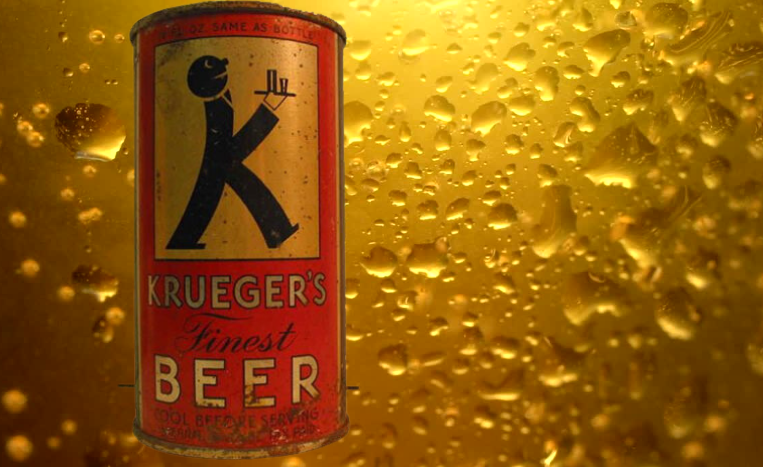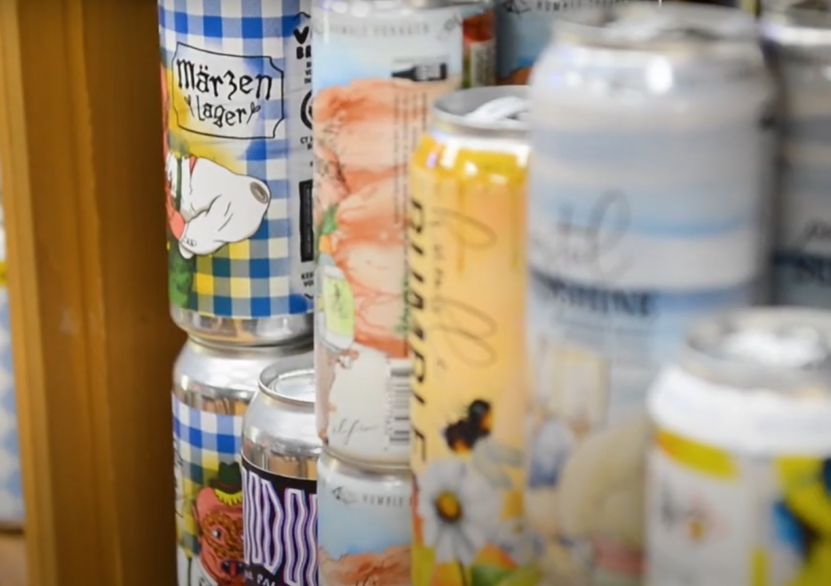When it comes to the world of beverages, the iconic beer can stands out as a symbol of refreshment and relaxation.
Whether you’re at a sporting event, a backyard barbecue, or simply unwinding after a long day, the familiar sight of a beer can in your hand is instantly recognizable.
However, have you ever wondered about the precise dimensions of this everyday object? How tall is a beer can exactly?
In this educational article, we delve into the details of beer can dimensions, exploring their variations, materials, and the reasons behind their designs.
Standard Dimensions

Beer cans come in various sizes and shapes around the world, but there is a standard size that has become widely accepted.
In the United States, the standard beer can size is 12 fluid ounces (355 milliliters). The dimensions of a typical 12 oz beer can are approximately 4.83 inches (12.3 cm) in height and 2.6 inches (6.6 cm) in diameter.
It’s interesting to note that these dimensions have become a sort of industry standard due to several factors, including production efficiency, consumer preferences, and convenience. These cans fit comfortably in most standard cup holders, making them ideal for on-the-go consumption.
The Evolution

The history of beer cans dates back to the mid-20th century, with the first commercial beer can hitting the market in 1935. However, the dimensions of beer cans have changed over the years, influenced by technological advancements, consumer demands, and marketing strategies.
In the early days, beer cans were often taller and narrower than the standard sizes we are accustomed to today.
These taller cans were initially popular because they resembled the traditional beer bottle, creating a sense of familiarity for consumers transitioning from bottles to cans.
However, as the beverage industry evolved and consumer preferences shifted, manufacturers began to explore different dimensions to enhance the drinking experience.
Variations

While the 12 oz beer can remains the standard size in the United States, it’s worth noting that variations exist worldwide. In some countries, you might encounter beer cans with different dimensions, catering to regional preferences and regulations. For instance:
European Standard: 330 ml
In Europe, the standard beer can size is typically 330 milliliters (about 11.2 fluid ounces). These cans are slightly smaller than the 12 oz cans commonly found in the United States.
European beer cans often have dimensions of approximately 4.53 inches (11.5 cm) in height and 2.6 inches (6.6 cm) in diameter. The smaller size is favored by many European consumers, as it aligns with the European preference for smaller portion sizes.
Tallboys and King Cans: Larger Than Life
In addition to the standard sizes, there are also larger beer cans known as “tallboys” or “king cans.” These cans can hold anywhere from 16 to 24 fluid ounces (473 to 710 milliliters) of beer, providing a more generous serving for those seeking a heartier refreshment.
The dimensions of tallboys vary, but they are generally taller and wider than the standard 12 oz cans.
The Science

The dimensions of a beer can are not merely arbitrary; they are carefully considered to optimize the drinking experience while maintaining the integrity of the beverage. The science behind beer can dimensions involves factors such as stability, pressure, and cooling efficiency.
Stability and Balance
One of the primary considerations when designing a beer can is its stability and balance. The can’s dimensions must ensure that it can stand upright without toppling over easily.
The base diameter of the can plays a crucial role in achieving this stability. A wider base provides better balance, reducing the likelihood of the can tipping over, especially on uneven surfaces.
Pressure and Structural Integrity
Beer is carbonated, which means it contains dissolved carbon dioxide gas that creates pressure within the can. To prevent the can from rupturing or exploding due to excessive pressure, manufacturers carefully calculate the can’s dimensions and material strength.
The cylindrical shape of the can helps evenly distribute the internal pressure, minimizing the risk of deformation or failure.
Cooling Efficiency
Another aspect of beer can design is cooling efficiency. Consumers expect their beverages to be refreshing and cold, so the dimensions of the can are designed to maximize contact with chilled surfaces, such as ice or the interior of a refrigerator.
The slim and cylindrical shape of beer cans enhances their ability to cool quickly, providing a satisfyingly cold drink in a short amount of time.
Material Matters: Aluminum vs. Steel

The material used to manufacture beer cans also affects their dimensions. Traditionally, beer cans were made from steel, but over the years, aluminum has become the preferred choice due to its lightweight nature, corrosion resistance, and recyclability.
Steel Beer Cans
Steel beer cans, which were prevalent in the mid-20th century, had slightly different dimensions compared to modern aluminum cans. These cans were often taller and narrower, resembling the shape of traditional beer bottles.
The use of steel presented challenges in terms of weight and transportation costs, which eventually led to the shift towards aluminum.
Aluminum Beer Cans
Aluminum beer cans revolutionized the beverage packaging industry. Their lightweight nature not only reduced shipping costs but also improved the overall consumer experience.
Aluminum cans are easier to open, carry, and dispose of, making them a convenient choice for both manufacturers and consumers.
The shift to aluminum also influenced the dimensions of beer cans. Aluminum cans allowed for greater flexibility in design, enabling manufacturers to create cans with wider openings for better drinking experiences, while still maintaining the structural integrity required to handle the pressures of carbonation.
Packaging and Branding

While the dimensions of beer cans are critical for functionality and consumer satisfaction, packaging and branding also play a significant role in shaping consumer perceptions and preferences.
Labeling and Design
The surface area of a beer can serves as valuable real estate for branding and marketing. Beverage companies carefully design their can labels to reflect their brand identity and catch the consumer’s eye.
The label design must also account for the curvature of the can, ensuring that the graphics and text appear visually appealing and easily readable.
Sustainability and Environmental Impact
In recent years, sustainability has become a central concern in packaging design. Many beverage companies are exploring ways to reduce their environmental footprint by using eco-friendly materials, minimizing packaging waste, and promoting recycling.
The dimensions of beer cans can impact their recyclability and the amount of material used in production. Smaller cans, for example, might use less material and generate less waste.
FAQs
Are there any health considerations linked to the dimensions of beer cans?
The dimensions of beer cans primarily focus on practical and consumer-oriented aspects, rather than direct health considerations.
However, the size of the opening might influence the speed of consumption, potentially affecting how quickly one drinks the contents. Responsible drinking and moderation remain key factors in maintaining a healthy balance.
Why do some beer cans have a wider base than others?
The width of the base in beer cans is designed to enhance stability and prevent tipping over. A wider base provides better balance, making the can less likely to fall over on various surfaces. This design consideration ensures a more enjoyable and spill-free drinking experience.
How do beer can dimensions impact carbonation levels?
While beer can dimensions play a role in distributing pressure evenly, they do not significantly impact carbonation levels.
The internal pressure within a beer can is primarily determined by the amount of dissolved carbon dioxide in the beverage and the seal of the can’s opening. Proper sealing and careful calculation of material strength are more critical in maintaining carbonation.
Can variations in beer can dimensions affect the taste of the beer?

Variations in beer can dimensions, such as different sizes or shapes, generally have a negligible impact on the taste of the beer.
The primary factors influencing taste are the quality of the beer itself, the temperature at which it’s consumed, and the drinker’s individual palate. However, the experience of holding and sipping from different-sized cans might subtly influence one’s perception of taste.
Do smaller beer cans contribute to environmental sustainability?
Smaller beer cans can potentially contribute to environmental sustainability by using less material for production and generating less waste.
Reduced packaging material means fewer resources consumed during manufacturing, and smaller cans might be preferred by environmentally conscious consumers looking to minimize their carbon footprint.
Are there any cultural reasons behind the different dimensions of beer cans in various regions?
Yes, cultural preferences and historical norms often influence the dimensions of beer cans in different regions. For example, European beer cans tend to be smaller to align with the European preference for smaller portion sizes.
These variations reflect the way cultural and regional factors shape consumer behaviors and choices.
Conclusion
The dimensions of a beer can extend far beyond simple measurements; they encompass a rich history of innovation, consumer preferences, and scientific considerations.
From their humble beginnings as steel vessels to the modern, aluminum marvels that we enjoy today, beer cans have evolved to enhance both the practicality and enjoyment of consuming our favorite beverages.
Whether you’re sipping from a 12 oz can, indulging in a tallboy, or exploring international variations, the dimensions of a beer can continue to shape our drinking experiences in more ways than we might realize.
So, the next time you crack open a cold can of your preferred brew, take a moment to appreciate the thoughtful design that goes into every sip.

